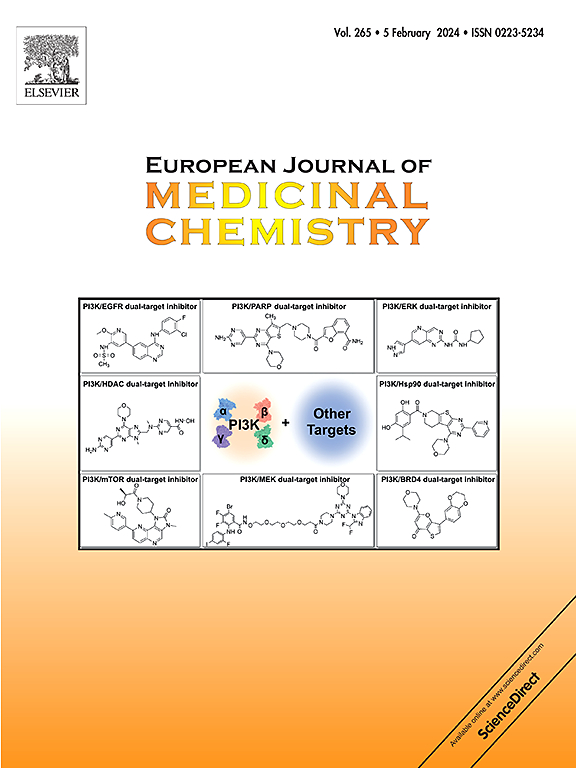Discovery of a novel molecular glue degrader targeting GSPT1/2 with a non-IMiD-based CRBN binder
IF 6
2区 医学
Q1 CHEMISTRY, MEDICINAL
引用次数: 0
Abstract
Targeting undruggable proteins by inducing proximity between E3 ligase and their substrates has emerged as an innovative strategy for tackling challenging diseases. In this study, we identified a novel GSPT1 degrader, 4a (KMG-1068), through screening of our in-house small molecule library. Treatment with 4a demonstrated significant anti-proliferative activity across multiple cell lines, which was diminished by co-treatment with MLN4924, suggesting the involvement of the Cullin-containing complex. Quantitative proteomic analysis indicated that 4a predominantly induces the degradation of GSPT1/2. We further validated that 4a-mediated GSPT1/2 degradation is dependent on both CUL4 and CRBN. Moreover, 4a forms a ternary complex with CRBN and GSPT1/2, albeit with weaker binding affinity compared to reported GSPT1 molecular glues. BRET assays and competition assays with pomalidomide demonstrated that 4a binds to the C-terminal IMiD binding site of CRBN, leading to the degradation of GSPT1. Despite lacking the characteristic glutarimide moiety present in other CRBN-based molecular glue degraders, 4a interacts effectively with the IMiD binding site of CRBN. Structural characterization through analog synthesis further underscored the importance of specific structural features for CRBN engagement, GSPT1/2 degradation, and anti-proliferative effects, establishing 4a as a promising novel GSPT1/2 degrader with significant therapeutic potential.


利用非 IMD 型 CRBN 粘合剂发现靶向 GSPT1/2 的新型分子胶降解剂
通过诱导E3连接酶与其底物之间的接近性来靶向不可药物蛋白已成为治疗具有挑战性疾病的一种创新策略。在这项研究中,我们通过筛选我们内部的小分子文库,鉴定了一种新的GSPT1降解物4a (kg -1068)。4a在多个细胞系中显示出显著的抗增殖活性,而与MLN4924共同处理则减弱了这种活性,这表明含有cullin复合物的参与。定量蛋白质组学分析表明,4a主要诱导GSPT1/2的降解。我们进一步验证了4a介导的GSPT1/2降解依赖于CUL4和CRBN。此外,4a与CRBN和GSPT1/2形成三元配合物,尽管与报道的GSPT1分子胶相比,其结合亲和力较弱。BRET实验和与pomalidomide的竞争实验表明,4a与CRBN的c端IMiD结合位点结合,导致GSPT1降解。尽管缺乏其他基于CRBN的分子胶降解剂所特有的戊二酰亚胺片段,但4a能有效地与CRBN的IMiD结合位点相互作用。通过模拟合成的结构表征进一步强调了特定结构特征对CRBN结合、GSPT1/2降解和抗增殖作用的重要性,确定4a是一种有前景的新型GSPT1/2降解物,具有显著的治疗潜力。
本文章由计算机程序翻译,如有差异,请以英文原文为准。
求助全文
约1分钟内获得全文
求助全文
来源期刊
CiteScore
11.70
自引率
9.00%
发文量
863
审稿时长
29 days
期刊介绍:
The European Journal of Medicinal Chemistry is a global journal that publishes studies on all aspects of medicinal chemistry. It provides a medium for publication of original papers and also welcomes critical review papers.
A typical paper would report on the organic synthesis, characterization and pharmacological evaluation of compounds. Other topics of interest are drug design, QSAR, molecular modeling, drug-receptor interactions, molecular aspects of drug metabolism, prodrug synthesis and drug targeting. The journal expects manuscripts to present the rational for a study, provide insight into the design of compounds or understanding of mechanism, or clarify the targets.

 求助内容:
求助内容: 应助结果提醒方式:
应助结果提醒方式:


